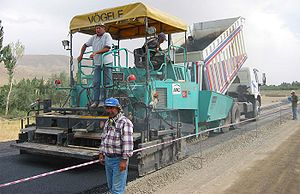asphalt paving Johannesburg, tar surfaces Pretoria, tar paving Johannesburg asphalt concrete
From Wikipedia, the free encyclopedia
(Redirected from Asphalt paving)
"Blacktop" redirects here. For other uses, see Blacktop (disambiguation).
Asphalt concrete (commonly called asphalt,[1] blacktop, or pavementin North America, and tarmac or bitumen macadam in Great Britain and Ireland) is a composite material commonly used to surface roads,parking lots, and airports. It consists of mineral aggregate boundtogether with asphalt, laid in layers, and compacted. The process was refined and enhanced by Belgian inventor and U.S. immigrant Edward de Smedt.[2] It is increasingly being used as the core of embankment dams.[3]
The terms "asphalt (or asphaltic) concrete", "bituminous asphalt concrete", and "bituminous mixture" are typically used only inengineering and construction documents, which define concrete as any composite material composed of mineral aggregate adhered with a binder. The abbreviation "AC" is sometimes used for "asphalt concrete" but can also denote "asphalt content" or "asphalt cement", referring to the liquid asphalt portion of the composite material.
Contents
[hide]Mixture formulations[edit]
Mixing of asphalt and aggregate is accomplished in one of several ways:[4]
- Hot mix asphalt concrete (commonly abbreviated as HMAC or HMA) is produced by heating the asphalt binder to decrease its viscosity, and drying the aggregate to remove moisture from it prior to mixing. Mixing is generally performed with the aggregate at about 300 °F (roughly 150 °C) for virgin asphalt and 330 °F (166 °C) for polymer modified asphalt, and the asphalt cement at 200 °F (95 °C). Paving and compaction must be performed while the asphalt is sufficiently hot. In many countries paving is restricted to summer months because in winter the compacted base will cool the asphalt too much before it is able to be packed to the required density. HMAC is the form of asphalt concrete most commonly used on high traffic pavements such as those on major highways, racetracks and airfields. It is also used as an environmental liner for landfills, reservoirs, and fish hatchery ponds.[5]
- Superpave, short for "superior performing asphalt pavement," is a pavement system designed to provide longer lasting roadways. Key components of the system are careful selection of binders and aggregates, volumetric proportioning of ingredients, and evaluation of the finished product.
- Warm mix asphalt concrete (commonly abbreviated as WMA) is produced by adding either zeolites, waxes, asphalt emulsions, or sometimes even water to the asphalt binder prior to mixing. This allows significantly lower mixing and laying temperatures and results in lower consumption of fossil fuels, thus releasing less carbon dioxide,aerosols and vapors. Not only are working conditions improved, but the lower laying-temperature also leads to more rapid availability of the surface for use, which is important for construction sites with critical time schedules. The usage of these additives in hot mixed asphalt (above) may afford easier compaction and allow cold weather paving or longer hauls. Use of warm mix is rapidly expanding. A survey of US asphalt producers found that nearly 25% of asphalt produced in 2012 was warm mix, a 416% increase since 2009.[6]
- http://www.lifestylepaving.co.za/




great content. useful and helpful
ReplyDeletehttps://www.treefellingpretoriaeast.co.za/